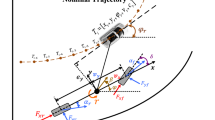Abstract
The control problem of trajectory based path following for passenger vehicles is studied. Comprehensive nonlinear vehicle model is utilized for simulation vehicle response during various maneuvers in MATLAB/Simulink. In order to follow desired path, a driver model is developed to enhance closed loop driver/vehicle model. Then, linear quadratic regulator (LQR) controller is developed which regulates direct yaw moment and corrective steering angle on wheels. Particle swam optimization (PSO) method is utilized to optimize the LQR controller for various dynamic conditions. Simulation results indicate that, over various maneuvers, side slip angle and lateral acceleration can be reduced by 10% and 15%, respectively, which sustain the vehicle stable. Also, anti-lock brake system is designed for longitudinal dynamics of vehicle to achieve desired slip during braking and accelerating. Proposed comprehensive controller demonstrates that vehicle steerability can increase by about 15% during severe braking by preventing wheel from locking and reducing stopping distance.
Similar content being viewed by others
References
WANG Guo-ye, ZHANG Juan-li, FEN Yan-li, ZHANG Yan-ru. Study on ESP control principle of light off-road vehicle based on brake/drive integrated control [J]. Physics Procedia, 2012, 25: 834–841.
BLUNDELL M, HARTY D. Multibody systems approach to vechicle dynamics [M]. London, UK: 2nd Ed. 2015: 451–533.
DU H, ZHANG N, NAGHDY F. Velocity-dependent robust control for improving vehicle lateral dynamics [J]. Transportation Research Part C: Emerging Technologies, 2011, 19(3): 454–468.
TAVOOSIV, KAZEMI R, OVEISI A. Nonlinear adaptive optimal control for vehicle handling improvement through steer-by-wire system [J]. Journal of Central South University, 2014, 21(1): 100–112.
MAHMOODI-K M, JAVANSHIR I, ASADI K, AFKAR A, PAYKANI A. Optimization of suspension system of off-road vehicle for vehicle performance improvement [J]. Journal of Central South University, 2013, 20(4): 902–910.
HAMERSMA H A, SCHALKELS P. Improving the braking performance of a vehicle with ABS and a semi-active suspension system on a rough road [J]. Journal of Terramechanics, 2014, 56: 91–101.
WANG L, TAN L, AN L, WU Z, LI L. Study on the ESP system based on fuzzy logic pid control and multibody dynamics [J]. Journal of Electrical Systems, 2012, 8(1): 57–75.
SONG J, CHE W S. Mechatronics comparison between braking and steering yaw moment controllers considering ABS control aspects [J]. Mechatronics, 2009, 19(7): 1126–1133.
LI B, DU H, LI W, ZHANG Y. Side-slip angle estimation based lateral dynamics control for omni-directional vehicles with optimal steering angle and traction/brake torque distribution [J]. Mechatronics, doi: 10.1016/j.mechatronics. 2014. 12. 001.
CHU L, GAO X, GUO J, LIU H, CHAO L, SHANG M. Coordinated control of electronic stability program and active front steering [J]. Procedia Environmental Sciences, 2012, 12: 1379–1386.
KECECI E F, TAO G. Adaptive vehicle skid control [J]. Mechatronics, 2006, 16(15): 291–301.
WANG X, FU M, MA H, YANG Y. Lateral control of autonomous vehicles based on fuzzy logic [J]. Control Engineering Practice, 2015, 34: 1–17.
FANG H D, CHEN J L, THUILOTB M. Robustanti-sliding control of autonomous vehicles in presence of lateral disturbances [J]. Control Engineering Practice, 2012, 19(5): 468–478.
TALVALA K L, KRITAYAKIRANA K, GERDES J C. Pushingthelimits: From lane keeping to autonomous racing [J]. Annual Reviews in Control, 2011, 35(1): 137–148.
ZAKARIA M A, ZAMZURI H, MAZLAN S A, HAFIZ S M, ZAINAL F. Vehicle path tracking using future prediction steering control [J]. Procedia Engineering, 2012, 41: 473–479.
MASHADI B, MAHMOODI-K M, KAKAE A H, HOSEINI R. Vehicle path following in the presence of driver inputs [J]. Proceedings of the Institution of Mechanical Engineers, Part K: Journal of Multi-body Dynamics, 2013, 227(2): 115–132.
PEDRO J O, DANGOR M, OLUROTIMI A, DAHUNSI M, MONTAZ A. Intelligent feedback linearization control of nonlinear electrohydraulic suspension systems using particle swarm optimization [J]. Applied Soft Computing, 2014, 24: 50–62.
MOKHIAMAR O, ABE M. Active wheel steering and yaw moment control combination to maximize stability as well as vehicle responsiveness during quick lane change for active vehicle handling safety [J]. Proc. Instn. Mech. Engrs., Part D: Journal of Automobile Engineering, 2002, 216: 115–124.
NAGAI M, HIRANO Y, YAMANAKA S. Integrated robust control of active rear wheel steering and direct yaw moment control [J]. Vehicle System Dynamics: International Journal of Vehicle Mechanics and Mobility, 1998, 29: 416–421.
MASHADI B, MAHMOODI-K M, AHMADIZADEH P, OVEISI A. A path-following driver/vehicle model with optimized lateral dynamic controller [J]. Latin American Journal of Solids and Structures, 2014, 11(4): 613–630.
FIALA E. Lateral forces on rolling pneumatic tires [J]. Zeitschrift V.D.I. 96, 1954, 29: 110–114. (in German).
CAGNINA L, ESQUIVEL S. A particle swarm optimizer for multi-objective optimization [M]. JCS, 2005: 204–210.
KENNEDY J, EBERHART J. The particle swarm: social adaption of knowledge [C]// Proc. IEEE Int. Conf. Evol. Comput, Indianapolis, 1997, Indonesia, IN: IEEE Press, 303–308.
RAJINIKANTH V, LATHA K. Particle swarm approach for identification of unstable processe [C]// Proceedings of the International Conference on Frontiers of Intelligent Computing: Theory and Applications (FICTA), Advances in Intelligent Systems and Computing. 2013, 199: 505–513.
MALIK S, DUTTA P, CHAKRABARTI S, BARMAN A. Parameter estimation of a PID controller using particle swarm optimization algorithm [J]. International Journal of Advanced Research in Computer and Communication Engineering, 2014, 3(3): 5827–5830.
YANG X J, WANG Z C, PENG W L. Coordinated control of AFS and DYC for vehicle handling and stability based on optimal guaranteed cost theory [J]. Vehicle System Dynamics, 2009, 47(1): 57–79.
ETEFFAGH M M, BEHKAMKIA D, PEDRAMMEHR S, ASADI K. Reliability analysis of bridge dynamic response in a stochastic vehicle-bridge interaction [J]. KSCE journal of Civil Engineering, 2014, 19(1): 220–232.
Author information
Authors and Affiliations
Corresponding author
Rights and permissions
About this article
Cite this article
Salehpour, S., Pourasad, Y. & Taheri, S.H. Vehicle path tracking by integrated chassis control. J. Cent. South Univ. 22, 1378–1388 (2015). https://doi.org/10.1007/s11771-015-2655-y
Received:
Accepted:
Published:
Issue Date:
DOI: https://doi.org/10.1007/s11771-015-2655-y




